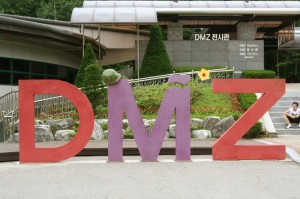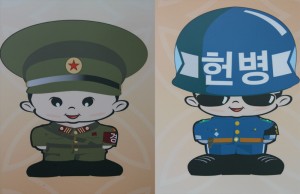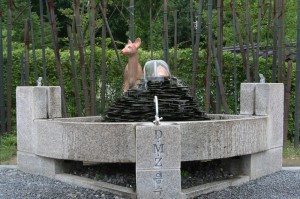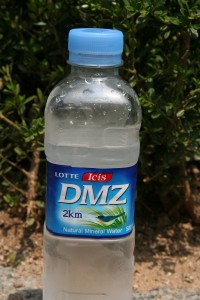 One of the most bizarre outings I’ve been on in a long, long time was my recent day trip to the Korean Demilitarised Zone, known as the DMZ(ee). Essentially it’s a strip of land that serves as a buffer zone between North and South Korea and it happens to be the most heavily militarised border in the world.
One of the most bizarre outings I’ve been on in a long, long time was my recent day trip to the Korean Demilitarised Zone, known as the DMZ(ee). Essentially it’s a strip of land that serves as a buffer zone between North and South Korea and it happens to be the most heavily militarised border in the world.
But when you go there – at least, from the South Korean side of the border – this sense of seriousness is absolutely no where to be seen. Instead, the zone takes on the form of a quasi family theme park, complete with primary coloured statues and animated pictures of North and South Korean soldiers. And while you’re having your photo taken next to the life sized letter M that is for “Militarised”, it’s easy to forget that over the past 50 years the DMZ has in fact been a deadly place for humans. Between 1953 and 1999 over 500 South Korean soldiers and 50 US soldiers have been killed inside the DMZ. But hey, why let those figures get in the way of a cheery family outing?
And while you’re having your photo taken next to the life sized letter M that is for “Militarised”, it’s easy to forget that over the past 50 years the DMZ has in fact been a deadly place for humans. Between 1953 and 1999 over 500 South Korean soldiers and 50 US soldiers have been killed inside the DMZ. But hey, why let those figures get in the way of a cheery family outing?
Over the last 30 odd years, four perfectly formed tunnels have been discovered heading from the North Korean end of the DMZ beyond the Military Demarcation Line into South Korea, and one of the principal attractions today at the ‘park’ is tunnel number 3, known “innocuously” as the ‘Third Tunnel of Aggression’. Discovered in 1978, the tunnel is 1.7km in length and runs through bedrock about 73m below ground. As a tourist, you enter this ride via a marble embossed lobby and rather large gift shop which sells a variety of DMZ branded souvenirs like T-shirts, miniature spoons, golf balls, stamps and a specially framed section of DMZ barbed wire. Then, it’s time to don a hardhat and head down a long and incredibly steep incline which leads to the tunnel that was thought to be designed for a surprise attack on Seoul. This is not an easy incline – to say that it’s steep is an understatement at best and yet, alongside “danger” barricades and other pretty signs indicating the presence of land-mines, fashionable Seoul women wearing stilettos pout at their sweet-smelling beaus on what appears to be a first date.
 Elsewhere in the theme park, a cinema shows the same short over and over. The movie, narrated by an American bloke with deep, rusty, raspy pipes – the kind synonymous with over-the-top voiceovers used in action movie promos, tells us that “once a dangerous zone filled with minefields, the DMZ has been transformed into a place of tranquility where humans and nature co-exist.” The musical score, a fusion of Kenny Gee inspired synth and Lloyd-Webber grandiosity builds to a mighty crescendo and we hear our trusty baritone declare that the “DMZ is…alive.”
Elsewhere in the theme park, a cinema shows the same short over and over. The movie, narrated by an American bloke with deep, rusty, raspy pipes – the kind synonymous with over-the-top voiceovers used in action movie promos, tells us that “once a dangerous zone filled with minefields, the DMZ has been transformed into a place of tranquility where humans and nature co-exist.” The musical score, a fusion of Kenny Gee inspired synth and Lloyd-Webber grandiosity builds to a mighty crescendo and we hear our trusty baritone declare that the “DMZ is…alive.”
You see, the lack of human contact along the 249 kms of the DMZ has created a kind of involuntary nature reserve, recognised today as one of the most well-preserved areas of temperate habitat in the world. This means that endangered animals like the Asiatic Black Bear, Red-Crowned Crane and Korean Tiger have the fortified fences and proliferation of land mines to thank for what our tour guide describes as a “natural world paradise.”
Back in Seoul, I purchase a bottle of DMZ water and drink wistfully, pondering whether the shiny liquid was in fact ‘bottled at source.’

